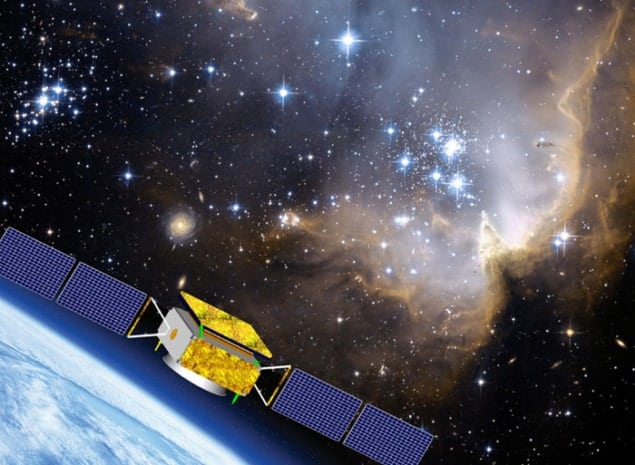
Scientists in China are preparing the country’s first dark-matter satellite to start taking data following its launch on 17 December 2015 from the Jiuquan Satellite Launch Center. The Dark Matter Particle Explorer (DAMPE), which is also dubbed “Wukong” (Monkey King) after the famous warrior from the 16th-century Chinese novel Journey to the West, is in a Sun-synchronous orbit at an altitude of about 500 km above the Earth. It is designed to operate for three years, with a possible extension of two further years.
Having taken four years to develop, DAMPE is designed to identify possible dark-matter signatures through an in-depth study of the particles making up cosmic rays. It is thought that dark-matter particles may annihilate or decay and then produce high-energy gamma rays or cosmic rays – in particular, electron–positron pairs. One of the probe’s main aims is to measure such particles with much higher energy resolution and energy range than achievable using existing space experiments.
To do this, DAMPE contains a plastic scintillator – built by a collaboration of scientists from China, Italy and Switzerland – to detect high-energy particles as well as a silicon–tungsten tracker to measure the direction of such particles. A bismuth-germanium-oxide calorimeter, meanwhile, will measure their energy. Finally, a neutron detector will aim to distinguish electrons from high-energy protons.
Yizhong Fan, deputy chief designer of DAMPE’s scientific application system, says that the team is currently carrying out calibrations on the craft that should be completed by the end of February, when the probe will begin full operations.
Part of a programme
DAMPE is the first satellite to be part of China’s Strategic Priority Program on Space Science. According to Ji Wu, director of the National Center for Space Science of the Chinese Academy of Sciences (CAS), three more satellites are scheduled for launch this year as part of this programme.
The Quantum Experiments at Space Scale, which is expected to launch in the first half of 2016, will aim to implement a high-speed quantum-key-distribution network between the satellite and Earth stations to test long-distance quantum communication. It will also investigate quantum-entanglement distribution, study quantum teleportation and test principles of quantum mechanics.
Also scheduled for launch in the first half of the year is Shijing-10 (SJ-10), which is a collaborative project involving 11 CAS institutes and six Chinese universities, as well as the European Space Agency and the Japanese space agency (JAXA). SJ-10 will carry out more than a dozen experiments to study microgravity fluid physics, microgravity combustion, materials science and space-radiation biology, among others.
The Hard X-ray Modulating Telescope (HXMT), meanwhile, will survey X-ray and gamma-ray sources in the region between 1 and 250 keV. HXMT’s chief scientist Tipei Li says that the space telescope has been tested and is ready for launch, which is expected sometime after September.



